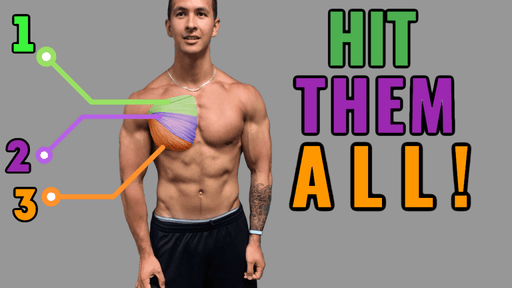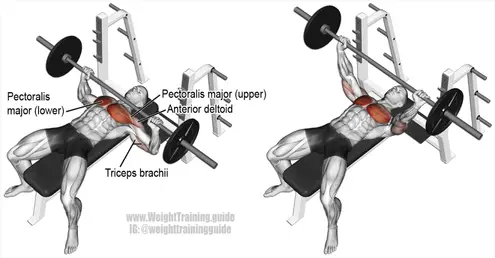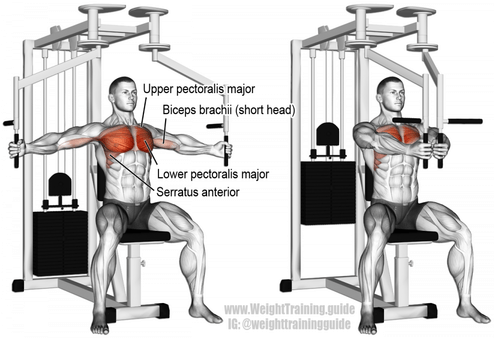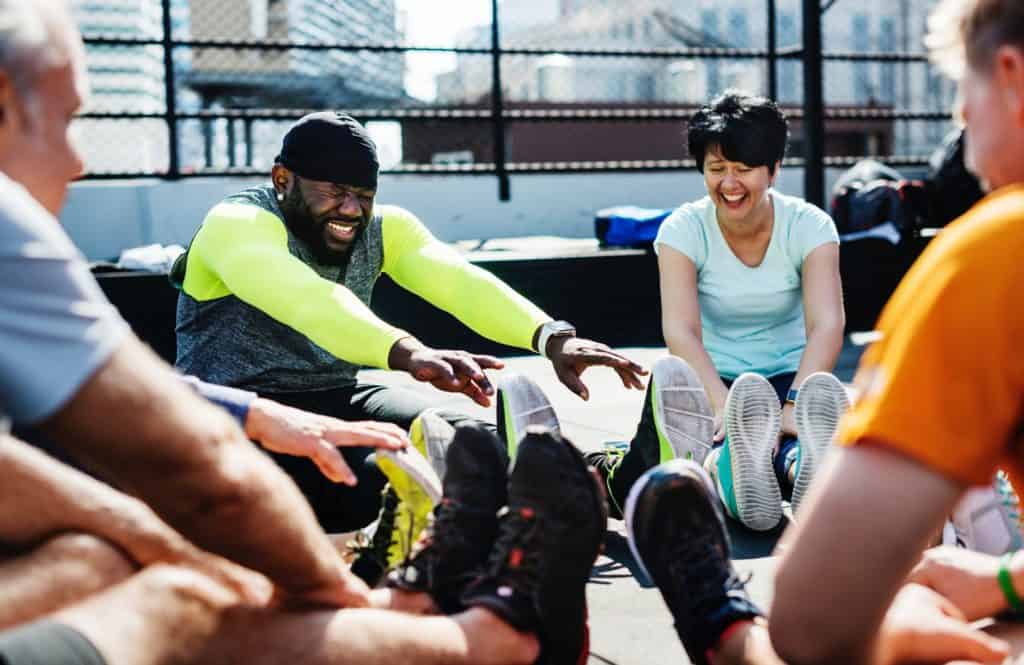Chest Day is King
Everyone loves chest day. The chest is often the first impression someone may have of us. Weak upper bodies can really hurt how others perceive us, and might even physically hurt us in some cases. For being the most popular day in the gym, there are quite a few misconceptions about it and most people do not quite understand chest day workouts as well as they could.
- What muscles are included in a good workout, and how do you best target them?
- How often do you need to train chest, and can you overdo it?
- Where are my weak spots, and how do I bring them up to par?
What Does Your Chest Do?
Your chest is the center of lots of the movement in your body. It is a major driving force for most push type activities you perform. Muscle strength and health is critical. A strong chest can help you to remove threats or objects that are too close to you, lift off things that may have fallen onto you, or other survival type reactions. A strong chest also helps to with other stuff as well.
A muscular upper body generally looks better, helping to attract attention, as well as working to straighten your posture and improve the efficiency of your breathing.
NOTE: A common fear that women have is that chest exercises will make you “bulky” or “manlike.” That simply isn’t true. Chest day is just important for women! Strengthening your chest will not only help with your posture, it will also serve to make everything else in the area lighter, reducing strain (and pain!) in your lower back.
Additionally, for someone to become “bulky” that has to be their goal. It is very challenging for someone to achieve the body-builder physique. Getting an enormous chest takes hours in the gym, and very specific diet focused on growing your muscles as big as they can go. Your body will not become “Bulky” without trying to get there.
When and how Often
Contrary to popular opinion it doesn’t need to happen on a Monday. Any day can be chest day! If you structure the workout properly, you will get the same results, regardless of if it is on a Monday morning or a Thursday evening. In fact, you might get better results if you push it to a different day of the week, since everyone else does it on Monday and you might not have to fight for equipment.
Pick a day and hit it hard. Aim to hit your chest at least once a week, but not more than twice if you are doing isolation and hypertrophy (growth) type exercises. Your body needs to recover when it gets a good workout in, so give it some time between workouts, and extra time if you go exceptionally hard or aren’t used to lifting.
Throw a specific chest day into your weekly rotation, and don’t be afraid to add supplemental chest exercises while doing some HIIT or other cardio another day of the week.
Similarly to any other exercise, you go too hard too often and you risk muscle damage, torn ligaments, or even rhabdomyolysis in extreme cases.
Anatomy of the Chest
Everyone knows about your pectorals, but chest day involves more than a single major muscle group. It also incorporates minor muscle groups, such as shoulders, and recruits stabilizers to help you get the weight to where you want it safely. Understanding the muscles involved in a good chest day workout can really help you tailor what you are doing, so you can reach your goals faster.
Pectoral Major
The pectoral major is a muscle group that spreads in a fan-type way from the shoulder to your breast bone. You have one per side, right and left. This muscle works along with the Pectoral Minor muscle to control the movement of your shoulder. It also plays a large part in your breathing, by ‘lifting’ the rib cage, allowing the lungs to expand.

Pectoral Minor
The pectoral minor muscle group exists underneath the pectoral major group. Together the two of them form the entirety of your pectoral muscles. Your pectoral minor group is responsible for pulling your scapula forward, or lifting your rib cage, depending on which one is meant to move at that moment.
Need some help?
Shape Success, Live Exceptionally
Hit that button, and get started today.
Serratus Anterior Muscle
This particular muscle is found wrapping around the side of the rib cage and back towards the scapula. It allows the scapula to rotate and lift the arms over 90 degrees.
Chest Day Warmups
Get the Blood Flowing
No matter what you are doing, you shouldn’t do it without a proper warm up. Getting the blood flowing and your muscles working helps prime them for what you are going to ask them to do. Jumping straight into heavy activity can cause injuries or poor performance, especially if you are new to regular exercise or not used to the activity you want to do. Chest day workout injuries can severely impact your day to day life, after all.
Jogging on the treadmill for 5-10 minutes is a great option to get the blood flowing and your heart rate up, but there are lots of other options to choose from such as walking on the stair master, using an elliptical machine, jump rope, or riding a stationary bike.
Dynamic Warmups
After your heart rate is up and the blood is flowing, another 5-10 minutes of dynamic stretching that specifically targets the muscle group you are working is a necessity. There are tons of options out there, but here are a few to get you going.
Forward Arm Circles
Stretch your arms all the way out in front of you. Start to rotate them slowly in as big of a circle as you can. Try reaching to the ceiling, before trying to reach the floor, without moving your torso. After 10 – 12 passes in a circle, change direction and go the other way. These help to get your shoulders loose, and blood flowing from the shoulder to your fingertips.
Chest Stretch
Hold your arms straight out in front of you, with your palms together. Keeping them straight and even with your shoulders, move them backwards as far back as they can reach. Return them to the starting position. Continue to do this movement 15 – 20 times, picking up speed slightly during each iteration. This movement will help you bring in the weight deeper before pushing it away again.
Chest Day Workout
Considering the major reason you have chest muscles is to do push actions, most of the movements you will be doing will include pushing. Just like every other workout, start with the heavier compound lifts and eventually move into isolation exercises. Also, keep tempo and breathing rhythm in mind while you lift.
Tempo is how fast or slow you perform an action. You want your muscles to remain under stress for a good period of time before reversing direction. Slowly lowering and lifting weights makes for better progress.
Breathing is generally brought in while you are on the easier part of a lift, and out on the harder part of the lift.
A good example of how to structure a chest day workout could be:
Barbell Bench Press: 4-5 sets of 1-10 reps (strength or size) or 12-15 reps (endurance)

The hallowed bench press. It should always, always be the first exercise you perform in any chest day workout. It recruits tons of muscles across the chest to push weight away from you. With the muscles being used, it should be one of your strongest lifts.
Lie on your back, lift the barbell off of the stand, slowly lower it to your chest, and return it up to the start position. After you are done, put the barbell back on the rack and stand up to shake it out.
NOTE: Make sure that you do not lock your elbows out, and keep your wrists straight and aligned with your forearms. This will help reduce the potential for injury.
Barbell Decline Press: 3-4 sets of 1-10 reps (strength or size) or 12-15 reps (endurance)
This is the exact same movement as the flat bench press, but with your bench at a slight decline rather than flat. Make sure to use a bench with something to hook your feet onto. This will keep you from sliding down with weight overhead.
Decline press targets the lower chest muscles, helping to carve out and define the lower pectoral muscles.
NOTE: People can generally lift a bit more on decline press thanks to how bodily mechanics line up and the recruitment of slightly different muscles.
Barbell Incline Press: 3-4 sets of 1-10 reps (strength or size) or 12-15 reps (endurance)
Incline press is yet another version of the flat bench press. In this particular rendition, the bench is slightly angled upwards, instead of flat or declined. It targets the upper chest and helps to build out a rounded, full looking upper body.
Incline press also targets the shoulders to a greater degree than flat or decline press. Too much of an incline can move away from recruiting chest muscles to strictly shoulders, so keep the angle to less than 30 degrees.

Dumbbell Press: 3 sets of 8-12
Dumbbell press involves nearly the same movement as flat bench press (are we seeing a pattern here?), but uses dumbbells instead of a barbell and is done on a flat bench without a rack (You know, for courtesy).
Find a suitably heavy set of dumbbells, lay flat, and lift them until your arms are extended and they are together above your chest. Slowly lower them down until they are as low as you can bring them, keeping your arms tucked at your sides. Return them to the starting position. That is one repetition.
Dumbbell Fly: 3 sets of 8-12 reps

Dumbbell flys have the same starting position as dumbbell presses: Lie flat, and lift the dumbbells over your head, bringing them weights together.
Keeping your arms extended and your elbows slightly bent, lower the weights outward to either side until you reach your maximum range of motion OR the weights are equal height with the chest. Whichever comes first.
NOTE: If you feel pain or a lot of strain on your shoulders: Stop. Reduce the weight if you need to. This exercise can put a lot of strain on your shoulder joint with the wrong form or using too much weight.
*Important note: if your body is fatigued and you need an extra break, walk around the gym, get a drink of water, or sit for a few minutes. Don’t push yourself farther than you can go.
Machine Fly: 3 sets of 12-15 reps
Machine fly’s are done on a machine, generally with metal fly arms. Sitting on the chair, extend your arms out to the sides and grab the handles. Slowly bring the handles forward, keeping your elbows slightly bent and your arms extended. When you reach the front and they come together, squeeze your chest and hold it for a few seconds. Slowly return the arms back to the sides.
Machine flys, and flys in general, work the inner chest muscles, helping to define that portion of the chest.

Pushups: 4 sets of 20 reps
Everyone knows the push up. It has been showcased in nearly every fitness routine, military recruitment clip, and athletic organization since the dawn of time. For good reason, too. Push ups recruit tons of muscle mass to push the body off of the floor.
The most common way to perform a push up is to lay on your stomach on the floor and push up with your arms, keeping your entire body straight.
If straight body push ups are too difficult, you can alter them by placing your knees onto the mat, behind your hips, and putting some of your body weight on them. Push yourself back up and repeat.
Post Workout
As with any workout, it is important to help your body to recover by following a few specific rules: stretch properly, fuel appropriately, and sleep enough.
Stretching
When you are done with a workout, regardless of what you are doing, a proper cool down will go miles towards reducing recovery time.
Take 5-10 minutes after you are done to stretch out the muscles you just worked out. These extra few minutes will help with your flexibility and reduce your chance of injury, on top of reducing recovery time.
Fueling

How you feed your body determines how well your body treats you. Everything from recovery time to immune system efficiency is affected by what you eat and your overall nutritional habits.
Make sure that you provide your body with necessary levels of protein, fats, and carbohydrates. If you need some help figuring out how to do that, click here.
Don’t forget the water, either. Dehydration is a killer, in more than one way. It slows down your recovery, sure, but it also affects every other aspect of your life. Bring enough water in to at least replace what you lost during your workout, but shoot for properly hydrating at all times.
Sleep
Your body does all its best work while it is sleeping. The time you are unconscious is when your body rebuilds itself from all of the damage it encounters throughout the day.
Make sure you get at least 7 hours a day, but the more the better.
To Sum It All Up
Chest muscles are vital for every day function. Not only are they necessary for posture and movement, they can literally save your life in some situations.
A weak chest, on the other hand, can be a major contributor to back pain, make you appear not confident, and tons of other negative outcomes.
Properly warming up followed by some good, consistent chest day workouts can go miles in helping you out in far more than the just the gym.
Let Us help You Out
At CONDITIONerd we are here to help you achieve better physical and mental health through exercise. Check out the plans we offer to our customers and see if you could benefit from working with our team. And if you have questions, you can always contact a CONDITIONerd team member.
Personal trainers, like those found here, can help guide you on your pathway towards reaching your fitness goals, whether that is getting bigger, stronger, faster, more lean, or just generally feeling better.
We can get you setup with a periodized workout plan, supplement information, and advice on nutrition to help you reach your goals.
The only thing you need is some motivation and a willingness to change some old habits.
Get into contact with us to find out what membership is right for you. In a CONDITIONerd program, you’ll be surrounded by others who can help you to get where you want to be.
Generally, our clients start to see some pretty awesome changes in 2-3 months time, some sooner.

